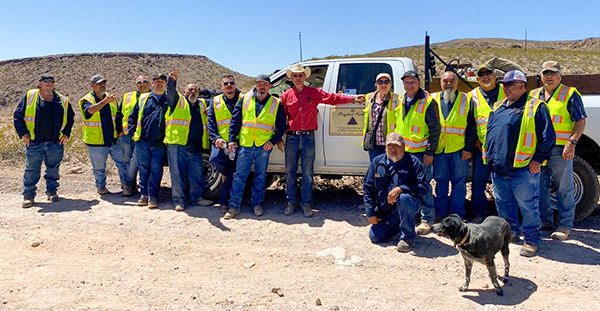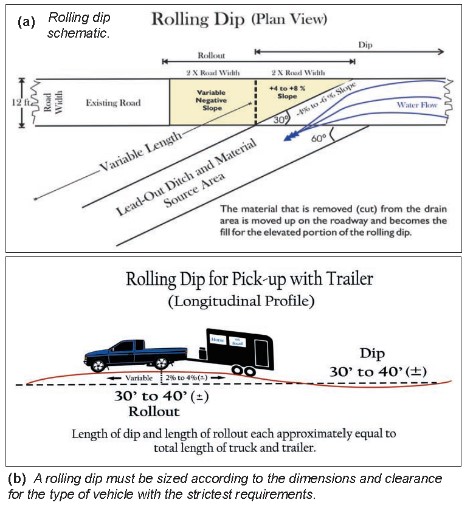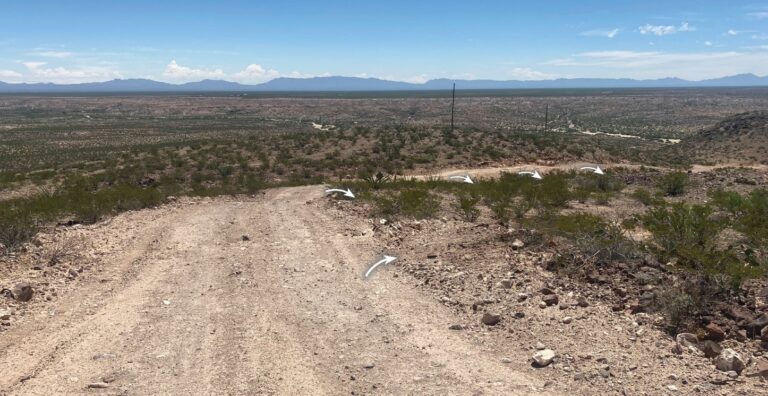Road Restoration and Workshop Successfully Kicks off NM WRRI Watershed Restoration Project
By Connie Maxwell, NM WRRI Postdoctoral Researcher

Participants from the Doña Ana County Road Maintenance Crew, Rangeland Hands, and NM WRRI at the completion of the road workshop at the Rincon Subbasins 319 watershed restoration project.
Restoration work recently began on the Rincon Subbasins 319 watershed restoration project, a project funded by a sub-grant agreement with the New Mexico Environment Department’s Clean Water Act Section 319 Watershed Project Implementation Program. The project goal is to better understand watershed dynamics and develop tools for land managers to achieve watershed restoration to address regional flooding and water supply challenges. The first step in this project was the restoration of the roads leading up to and roads within the project area. Steve Carson of Rangeland Hands structured the road restoration to be a workshop for the Doña Ana County (DAC) Roads Division crew so that the restoration knowledge could benefit the entire county. The three-day workshop began with a classroom overview of road restoration approaches and finished with trained actual restoration activities in the watershed restoration project. The road maintenance worker in charge of the area subsequently completed maintenance on the road leading to the project area.
Erosion on rural dirt roads from flood flows is a severe problem in DAC, where half of the approximately 1,400 miles of roads that the DAC Roads Division crews maintain are rural dirt roads. Carson’s approach is summarized in his training document: “It is not a road problem, it is a surface water management problem! If we correctly manage the water off the roads, we will solve most of the erosional situations on the road’s surface. This will reduce the need to continually maintain the road as well as harvesting the water onto the adjoining roadside to promote vegetation and disperse sediment.” The road crew operators are in essence water managers and need to read the landscape and physically measure the slopes to apply the proper restoration and maintenance approaches. Erosion occurs when water flows on the road for too long, becoming in essence an arroyo. Good road design requires that water is frequently drained off the road and maintenance preserves, restores, or adds drainage as needed. The approaches are all essentially variations on a rolling dip (Figure 1a and 1b). The functions of the drains have two parts, a dip dug into the road drained to a lead-out ditch, which drains the flow off the road, and a bump added to prevent water from coursing down the road.

Figure 1a and 1b. Road restoration practice of a rolling dip (a) schematic plan and (b) section, from Bill Zeedyk’s book (p. 18, here with format modifications), A Good Road Lies Easy on the Land, Water Harvesting from Low-Standard Rural Roads.

Rolling dips on road in and leading to Rincon Subbasins 319 project minimizing the quantity of flows on the road at any one location. Arroyos indicate approximate location of drainage dips created with “rollouts” just beyond to prevent flows from continuing down the road.
Carson explained in the workshop, “The landscape is a literal language. We don’t speak it, but we see it. And we have to learn that language because we need to know how to read the road, especially the upslope side, and tell how much water is taken off of it based on topography. . . . Is it sandy? Is it well-vegetated, etc? This is an extremely important part of this work.”
The project is already having a positive impact on the community. Two weeks after the workshop, Steve Wilmeth, a rancher in the region and a former Doña Ana Soil and Water Conservation District board member, emailed and confirmed the workshop was having an effect. “I need to say ‘Thank You!’ in regards to training you orchestrated for county road maintenance. I went up and looked at the recent day’s work on our roads and simply couldn’t believe what was happening. Our area operator . . . was placing effective diversions and cutouts in the form I have long advocated. . . . Wow! . . . [W]hile we have a long way to go in many respects, this is a good start. . . . The approach is exactly what must be pursued.”
NM WRRI in collaboration with the South Central NM Stormwater Management Coalition (Stormwater Coalition) initiated the Rincon Subbasins 319 project restoration approach with the goal to harness storms that come in fewer and more intense events, spreading and slowing flows to achieve revegetation. Practices that slow and spread flows in the upper watershed are currently being installed in the project and will be substantially complete by the end of June. Monitoring will assess the effects on the goal and inform planning for the region..
